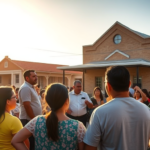**Hidalgo County Residents Line Up for Utility Bill Assistance Amid Process Overhaul**
As January unfolds in Hidalgo County, long lines of residents waiting for utility bill assistance mark a new year and a new challenge. Recent changes by the Hidalgo County Community Service Agency (CSA) have altered the application process for this essential aid, affecting thousands of Valley residents grappling with high utility costs.
**A Sea of Concerned Faces**
The sight outside the CSA office underscores an urgent need. As of Monday, 118 hopeful applicants lined up, some camping out overnight to secure one of the limited 40 daily spots available for in-person applications. These spots are highly coveted, especially with the added complication of a disconnection notice — a reality for five families served each day, with a slight increase on Fridays.
This shift to in-person requirements in January has sparked both urgency and anxiety in South Texas communities. “We decided to have a more measured approach, a more deliberate approach,” explains Jaime Longoria, the executive director of the Hidalgo County CSA, defending the recent structural changes aimed at improving efficiency and fairness in allocating aid.
**A Sizable Challenge**
Amidst an influx of applicants, the CSA underscores that the current measures are temporary. Starting February, the agency will reopen its online application portal — a move expected to alleviate on-site congestion while accommodating up to 500 applications per month. The agency receives nearly $7 million in federal funds to support these initiatives, crucial for families living below the federal poverty line.
But financial aid for utilities is more than numbers; it’s a lifeline for many in the RGV. “Most people would prefer to apply at home,” Longoria notes, emphasizing the forthcoming reopening of the portal as a means to offer Valley residents a more convenient and less invasive option.
**Local Impact and Broader Context**
Utility assistance in Hidalgo County isn’t a standalone issue. It’s an integral part of a larger regional and national narrative concerning economic hardship, exacerbated by increasing costs of living. Many families in the RGV face the cumulative pressure of utility bills, housing costs, and medical expenses with limited resources. This has become particularly acute as winter temperatures, albeit mild in many regions, lead to spikes in heating and related utility costs.
Critically, the necessity for such assistance intersects various community issues, from housing insecurity to broader matters of energy sustainability and affordability. In a region where summer electricity needs often overshadow colder months, this winter challenge highlights the year-round vulnerability of certain demographics within the community.
**Valley Residents: Voices of Hope and Concern**
Interviews with residents emphasize the value of utility assistance and the frustrations associated with the new process. Rosa Martinez, who traveled from Mission to apply, described her overnight wait. “I was surprised at how many people are in the same situation,” she reflected. “The bills keep climbing, and every bit of help counts.”
For others, like Roberto Torres, a father of four, the stakes are even higher. “Facing a disconnection notice means I’ve got no choice. I need to keep the lights on for my kids,” Torres said, highlighting an emotional aspect often overlooked in statistical reports.
**Connections to Community Initiatives**
Beyond immediate financial relief, such aid connects with other community efforts aiming to alleviate socio-economic pressures. For instance, initiatives like the Point Isabel ISD’s fundraising for California wildfire victims demonstrate a shared spirit of support and solidarity within the Valley. These actions, although targeted outside the immediate geographic area, reflect a broader ethos of communal care and collective action, integral to the RGV’s cultural fabric.
**Looking Ahead: What Lies in Store?**
As February approaches, the CSA’s transition back to online applications promises a more manageable flow of assistance requests. Yet, the underlying challenges remain — how to sustain substantial support systems able to meet ongoing and emergent needs.
Long term, Valley stakeholders may need to explore more sustainable solutions, potentially involving local energy programs or state and federal policy adjustments that address the root causes of utility expense spikes. Economic growth, like that seen in the expansion of the McAllen flight academy or initiatives combating human trafficking, highlight the Valley’s potential for strategic developments that prioritize resident welfare and opportunities.
In the meantime, residents are encouraged to explore resources available through the CSA by visiting their website or calling their helpline. For many, these steps could mean the difference between vulnerability and managing the winter season effectively.
**Conclusion**
As residents continue to face these challenges, the resilience evident in their collective response offers a striking testimony to community strength. Amidst the lines that form outside the Hidalgo County CSA, there’s a palpable sense of shared struggle and the undeniable search for hope — a defining narrative of the RGV’s ongoing story.
For additional assistance, residents can contact the Hidalgo County Community Service Agency directly, ensuring they are informed of applicable resources and upcoming changes to the application process. The CSA is located at [CSA Address] and can be reached at [CSA Phone Number]. Their website, [CSA Website URL], provides more details on eligibility and assistance programs available.







